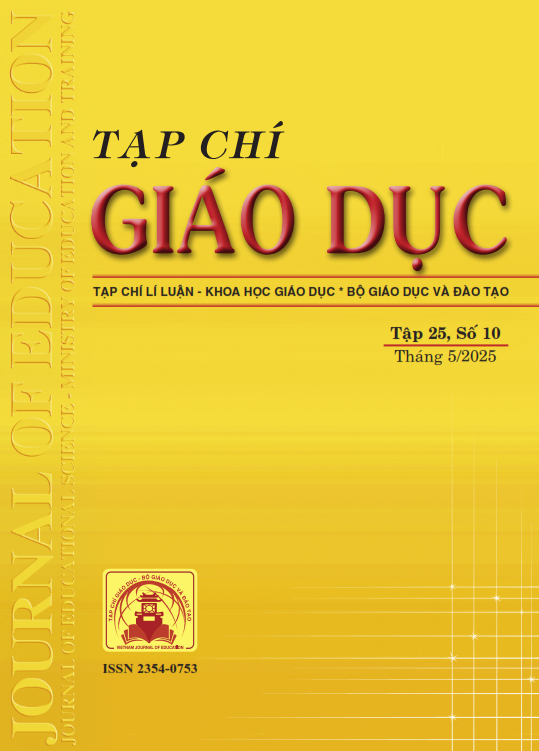Sự kiệt sức nghề nghiệp của giáo viên: Nghiên cứu theo các yếu tố nhân khẩu học
- Từ khóa:
- Burnout
- demographic factors
- teacher
- relationship
Tóm tắt
Recent studies on teacher burnout have become increasingly prevalent worldwide, contributing to the understanding of the reasons behind the growing trend of teacher attrition. This study aims to examine the relationship between demographic factors and burnout among Vietnamese teachers. The research was conducted on a sample of 1,205 teachers from preschool to high school levels in Vietnam. The findings indicate that most of the demographic factors studied show statistically significant differences in burnout levels, except for religion and teaching level. While demographic factors (excluding religion) have a weak correlation with burnout, the strongest correlation is found with the teacher’s living area, whereas educational attainment shows the weakest correlation. From there, the author makes recommendations on management measures for policy makers and educational institution managers in developing interventions to reduce teacher burnout. These recommendations, if implemented synchronously, can help reduce the risk of burnout for Vietnamese teachers.
Tài liệu tham khảo
Ahola, K., Honkonen, T., Kivimäki, M., Virtanen, M., Isometsä, E., Aromaa, A., & Lönnqvist, J. (2008). Contribution of burnout to the association between job strain and depression: The Health 2000 Study. Journal of Occupational and Environmental Medicine, 50(10), 1216-1223. https://doi.org/10.1097/JOM.0b013e31817e6810
Antoniou, A. S., Polychroni, F., & Vlachakis, A. N. (2006). Gender and age differences in occupational stress and professional burnout between primary and high-school teachers in Greece. Journal of Managerial Psychology, 21(7), 682-690. https://doi.org/10.1108/02683940610690213
Burke, R. J., Greenglass, E. R., & Schwarzer, R. (1996). Predicting teacher burnout over time: Effects of work stress, social support, and self-doubts on burnout and its consequences. Anxiety, Stress, & Coping, 9(3), 261-275. https://doi.org/10.1080/10615809608249406
Currall, S. C., Towler, A. J., Judge, T. A., & Kohn, L. (2005). Pay satisfaction and organizational outcomes. Personnel Psychology, 58(3), 613-640. https://doi.org/10.1111/j.1744-6570.2005.00245.x
Chang, M. L. (2009). An appraisal perspective of teacher burnout: Examining the emotional work of teachers. Educational Psychology Review, 21(3), 193-218. https://doi.org/10.1007/s10648-009-9106-y
Eldor, L., & Shoshani, A. (2017). Are you being served? The relationship between school climate for service and teachers' engagement, satisfaction, and intention to leave: A moderated mediation model. The Journal of Psychology, 151(4), 359-378. https://doi.org/10.1080/00223980.2017.1291488
Fernet, C., Guay, F., Senécal, C., & Austin, S. (2012). Predicting intraindividual changes in teacher burnout: The role of perceived school environment and motivational factors. Teaching and Teacher Education, 28(4), 514-525. https://doi.org/10.1016/j.tate.2011.11.013
Freudenberger, H. J. (1974). Staff burn‐out. Journal of Social Issues, 30(1), 159-165. https://doi.org/10.1111/j.1540-4560.1974.tb00706.x
Hakanen, J. J., Bakker, A. B., & Schaufeli, W. B. (2006). Burnout and work engagement among teachers. Journal of School Psychology, 43(6), 495-513. https://doi.org/10.1016/j.jsp.2005.11.001
Ingersoll, R. M. (2001). Teacher turnover and teacher shortages: An organizational analysis. American Educational Research Journal, 38(3), 499-534. https://doi.org/10.3102/00028312038003499
Kokkinos, C. M. (2007). Job stressors, personality and burnout in primary school teachers. British Journal of Educational Psychology, 77(1), 229-243. https://doi.org/10.1348/000709905X90344
Kyriacou, C. (2001). Teacher stress: Directions for future research. Educational Review, 53(1), 27-35. https://doi.org/10.1080/00131910120033628
Lau, P. S. Y., Yuen, M. T., & Chan, R. M. C. (2005). Do demographic characteristics make a difference to burnout among Hong Kong secondary school teachers? Social Indicators Research, 71(1), 491-516. https://doi.org/10.1007/s11205-004-8033-z
Liu, S., & Onwuegbuzie, A. J. (2012). Chinese teachers' work stress and their turnover intention. International Journal of Educational Research, 53, 160-170. https://doi.org/10.1016/j.ijer.2012.03.006
Madigan, D. J., & Kim, L. E. (2021). Does teacher burnout affect students? A systematic review of its association with academic achievement and student-reported outcomes. International Journal of Educational Research, 105, 101714. https://doi.org/10.1016/j.ijer.2020.101714
Mäkelä, K., Hirvensalo, M., & Whipp, P. R. (2015). Determinants of PE teachers career intentions. Journal of Teaching in Physical Education, 34(4), 680-699. https://doi.org/10.1123/jtpe.2014-0081
Maslach, C., & Jackson, S. E. (1981). The measurement of experienced burnout. Journal of Occupational Behavior, 2(2), 99-113. https://doi.org/10.1002/job.4030020205
Maslach, C., & Leiter, M. P. (2016). Understanding the burnout experience: Recent research and its implications for psychiatry. World Psychiatry, 15(2), 103-111. https://doi.org/10.1002/wps.20311
Oh, H. (2023). Negative aspects of teacher burnout problem on educational organization. In Organizational behavior - Negative aspects. IntechOpen. https://doi.org/10.5772/intechopen.1001062
Pas, E. T., Bradshaw, C. P., & Hershfeldt, P. A. (2012). Teacher- and school-level predictors of teacher efficacy and burnout: Identifying potential areas for support. Journal of School Psychology, 50(1), 129-145. https://doi.org/ 10.1016/j.jsp.2011.07.003
Purvanova, R. K., & Muros, J. P. (2010). Gender differences in burnout: A meta-analysis. Journal of Vocational Behavior, 77(2), 168-185. https://doi.org/10.1016/j.jvb.2010.04.006
Schaufeli, W. B., De Witte, H., & Desart, S. (2020). Manual Burnout Assessment Tool (BAT) – Version 2.0. KU Leuven, Belgium: Internal report.
Schwarzer, R., Schmitz, G. S., & Tang, C. (2000). Teacher burnout in Hong Kong and Germany: A cross-cultural validation of the Maslach Burnout Inventory. Anxiety, Stress & Coping, 13(3), 309-326. https://doi.org/10.1080/10615800008549268
Skaalvik, E. M., & Skaalvik, S. (2010). Teacher self-efficacy and teacher burnout: A study of relations. Teaching and Teacher Education, 26(4), 1059-1069. https://doi.org/10.1016/j.tate.2009.11.001
UNESCO. (2023). Global education monitoring report, 2023: Technology in education: A tool on whose terms? UNESCO Publishing.
Vallejo, M. P., Madigan, P. J., & Lavian, S. B. (2023). Teacher burnout and student learning in secondary education in Kalundborg, Denmark. Journal of Education, 6(5), 1-11. https://doi.org/10.53819/81018102t5260
WHO (2019). Burn-out an “occupational phenomenon”: International Classification of Diseases. https://www.who.int/ news/item/28-05-2019-burn-out-an-occupational-phenomenon-international-ssification-of-diseases
Tải xuống
Đã Xuất bản
Cách trích dẫn
Số
Chuyên mục
Giấy phép

Tác phẩm này được cấp phép theo Ghi nhận tác giả của Creative Commons Giấy phép quốc tế 4.0 .












